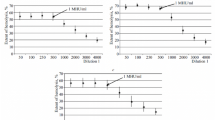Abstract
Total hemolytic activity of serum (CH50), complement components C3 and C4 α1antitrypsin (α1AT), α1antichymotrypsin (α1X), antithrombin III (AT III), α2macroglobulin (α2M), and inter-α-inhibitor (I-α-I) were measured in 23 Japanese and 19 European children with the Mucocutaneous Lymph node Syndrome (MCLS) during the acute phase of disease. Second sera, obtained after day 20 were available from 18 Japanese and 10 European children.
In 28 out of 31 children with mild disease, as assessed by the coronary risk score of Asai and Kusakawa, complement was normal or elevated during the acute phase. In 10 out of 11 children with high risk scores, CH50 was below the normal range. One child in this group had ECG changes during the acute phase, one patient died and two others developed coronary aneurysms.
C1I was elevated in all 42 cases α1AT in 40, and α1X in 38 patients. α1AT was depressed in two children, one of whom developed an aneurysm. One of the four children with depression of α1X died of myocardial infarction. Decreased concentrations of AT III, α2M and I-α-I were frequent and tended to mark the more severe courses of the disease. A third group of 20 children was evaluated 5 weeks to 6 months after the acute illness. Mean concentrations of all five protease inhibitors were completely normalized in this group.
The results of this study indicate that consumption of complement and of protease inhibitors occurs in many cases of MCLS during the acute phase. Determination of CH50 appears to be useful to identify high risk patients early in the course of their illness. Transient deficiency of substances for control of inflammation may in part be responsible for the severe vascular lesions seen in some patients.
Similar content being viewed by others
References
Asai T (1981) Treatment and management of Kawasaki disease. Jpn J Pediatr 34:477–488
Cremer H, Kleihauer E, Rieger C, Runge H, Schweier P (1981) Das Kawasaki-Syndrom (Mukokutanes Lymphknotensyndrom=MCLS) in der Bundesrepublik. Pädiat Prax 25:243–260
Damiano A, Zulaica D, Cuadrado E, Ochao M (1981) Immunologic findings in Kawasaki Disease. Ann Int Med 94:138–139
Egeberg O (1964) Inherited antithrombin deficiency causing thrombophilia. Thrombos Diathes Haemorrh 13:516–520
Fossard C, Thompson RA (1977) Mucocutaneous lymph-node syndrome (Kawasaki disease): probable soluble-complex disorder Br Med J 1:883
Ganrot PA, Schersten B (1967) Serum α2-macroglobulin concentration and its variation with age and sex. Clin Chim Acta 15:113–120
Heimburger N (1975) Proteinase inhibitors of human plasma-their properties and control functions. In: Proteases and Biological Control (E. Reich, D. B. Rifkin, E. Shaw. editors), Cold Spring Harbor Laboratory, pp 367–386
Hochstrasser K, Bretzel G, Feuth H, Hilla W, Lempart K, (1976) The inter-α-trypsin inhibitor as precursor of the acidstable proteinase inhibitors in human serum and urine. Z Physiol Che 357:153–162
Kato H, Koike S, Yamamoto M, Ito Y, Yano E (1975) Coronary aneurysms in infants and young children with acute febrile mucocutaneous lymphnode syndrome. J Pediatr 86:892–898
Kawasaki T, Kosaki F, Okawa S, Shigematsu I, Yanagawa H (1974) A new infantile febrile mucocutaneous lymphnode syndrome (MCLS) prevailing in Japan. Pediatrics 54:271–274
Kusakawa S (1979) Cardiovascular lesion in Kawasaki disease (MCLS). Jpn J Med Biol 32:239–250
Kusakawa S, Heiner DC (1976) Elevated levels of Immunoglobulin E in the acute febrile mucocutaneous lymphnode syndrome. Pediatr Res 10:108–110
Morens DM, Anderson LJ, Hurwitz ES (1980) National surveillance of Kawasaki disease. Pediatrics 65:21–25
Ohlsson K, Åkesson U (1976) 97-2 interaction with cationic proteins from granulocytes. Clin Chim Acta 73: 285–291
Thaler E, Kleinberger G (1979) Sepesis und Blutgerinnung. Intensivmed. 16:54–60
Travis J, Bowen J, Baugh, R (1978) Human α l-antichymotrypsin: interaction with chymotrypsin-like proteinases. Biochemistry 17:5651–5656
Travis J, Garner D, Bowen J (1978) Human α l-antichymotrypsin: purification and properties. Biochemistry 17:5647–5651
Weindling AM, Levinsky RJ, Weindling AM (1979) Circulating immune complexes in mucocutaneous lymphnode syndrome (Kawasaki disease). Arch Dis Child 54:241–242
Yamada K, Fukumoto T, Shinkai A, Shirahata A, Meguro T (1978) The platelet functions in acute febrile mucocutaneous lymph node syndrome and a trial of prevention for thrombosis by antiplatelet agent. Acta Haematol Jpn 41:791–802
Yata J (1977) In: Yuicki Shiokawa (ed) Vascular lesions of collagen diseases and related conditions. University Park Press, Baltimore London Tokyo, pp 335–336
Author information
Authors and Affiliations
Rights and permissions
About this article
Cite this article
Rieger, C.H.L., Kawasaki, T., Yanase, Y. et al. Complement and protease inhibitors in the mucocutaneous lymph node syndrome. Eur J Pediatr 140, 92–97 (1983). https://doi.org/10.1007/BF00441650
Received:
Accepted:
Issue Date:
DOI: https://doi.org/10.1007/BF00441650




